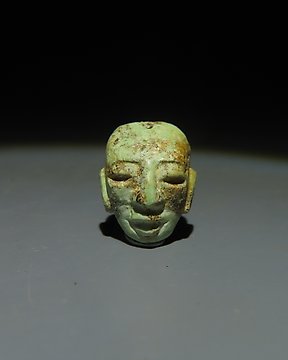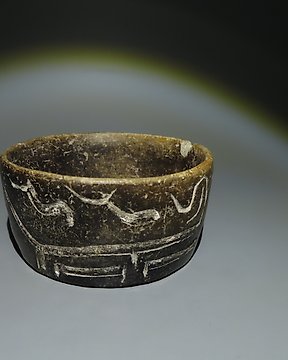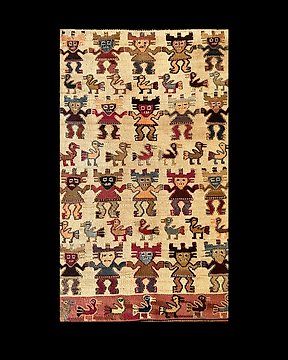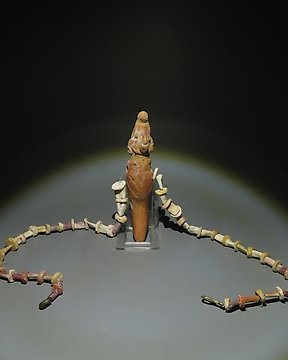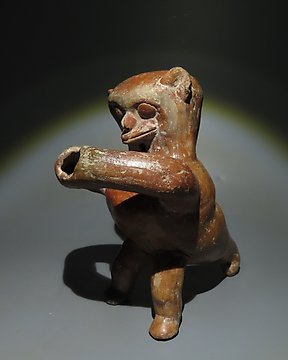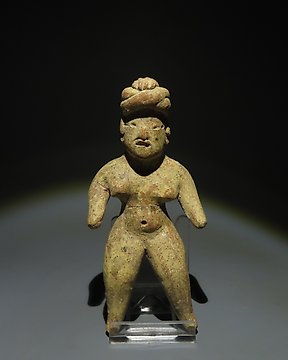Perfect transaction. Good communication and piece better than expected.
Voir la traductionMoche-Chimu Travail de plumes sur la tapisserie de divinité pélican noire de cape de cérémonie en coton. avec sur fond blanc, vagues oranges sur le bord inférieur (plumes jaunes, oranges, noires et blanches) - 60×0.05×60 cm - (1)
Nº 84672223
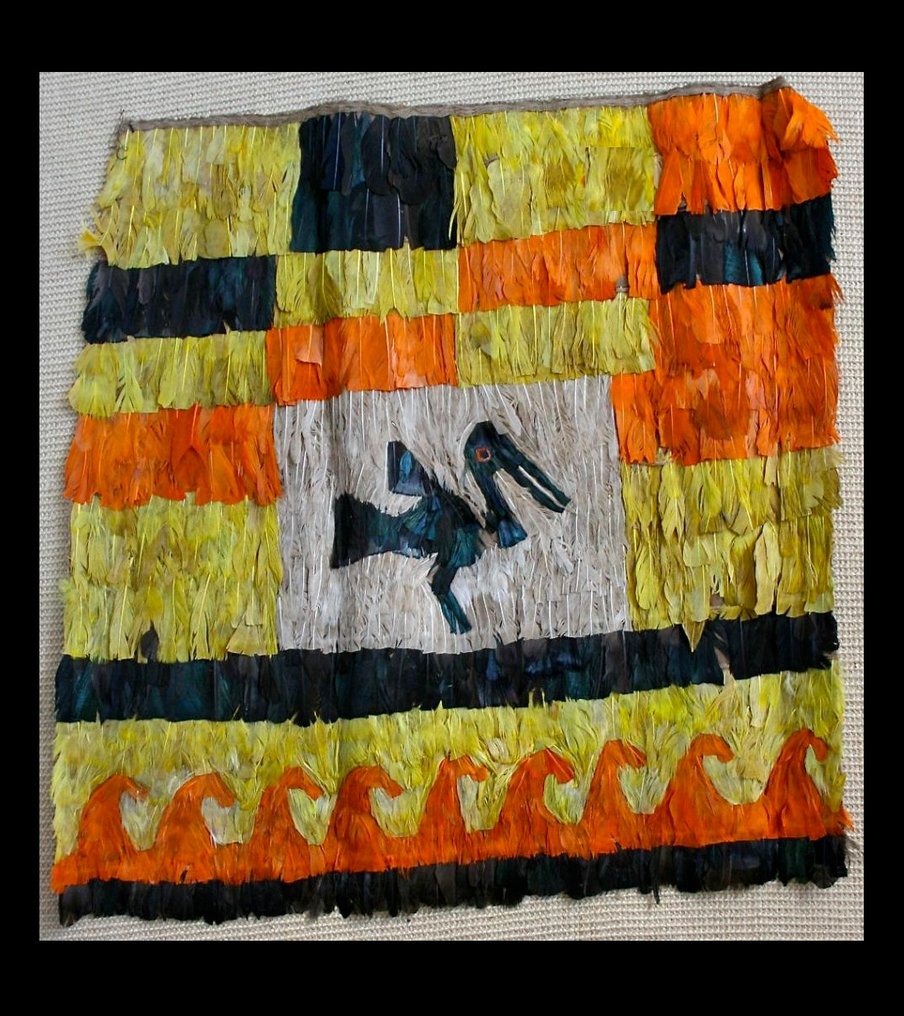
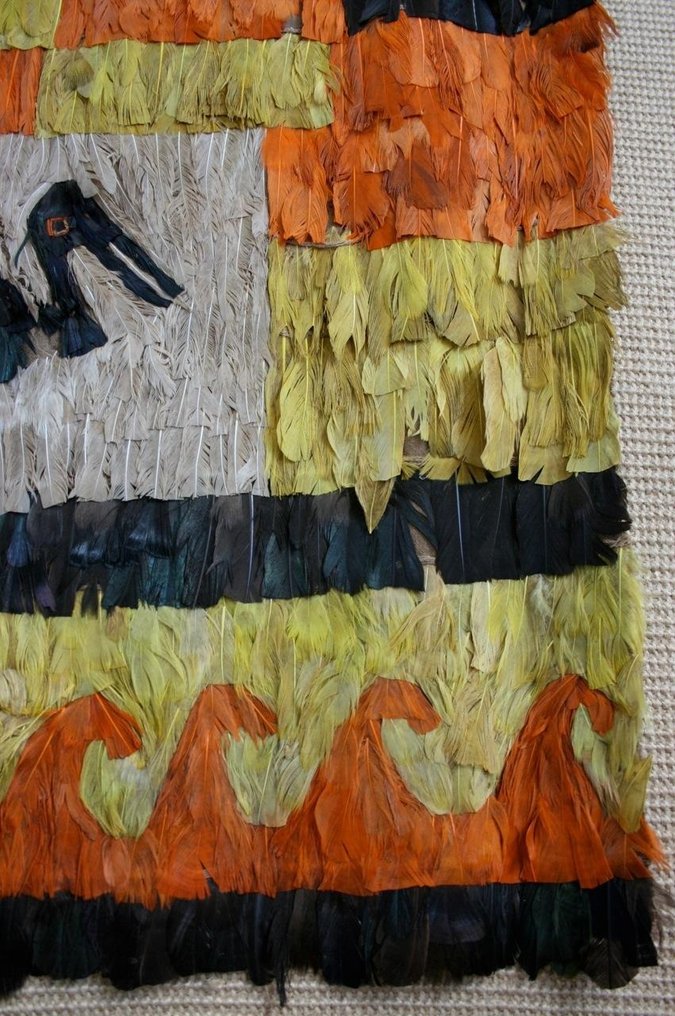
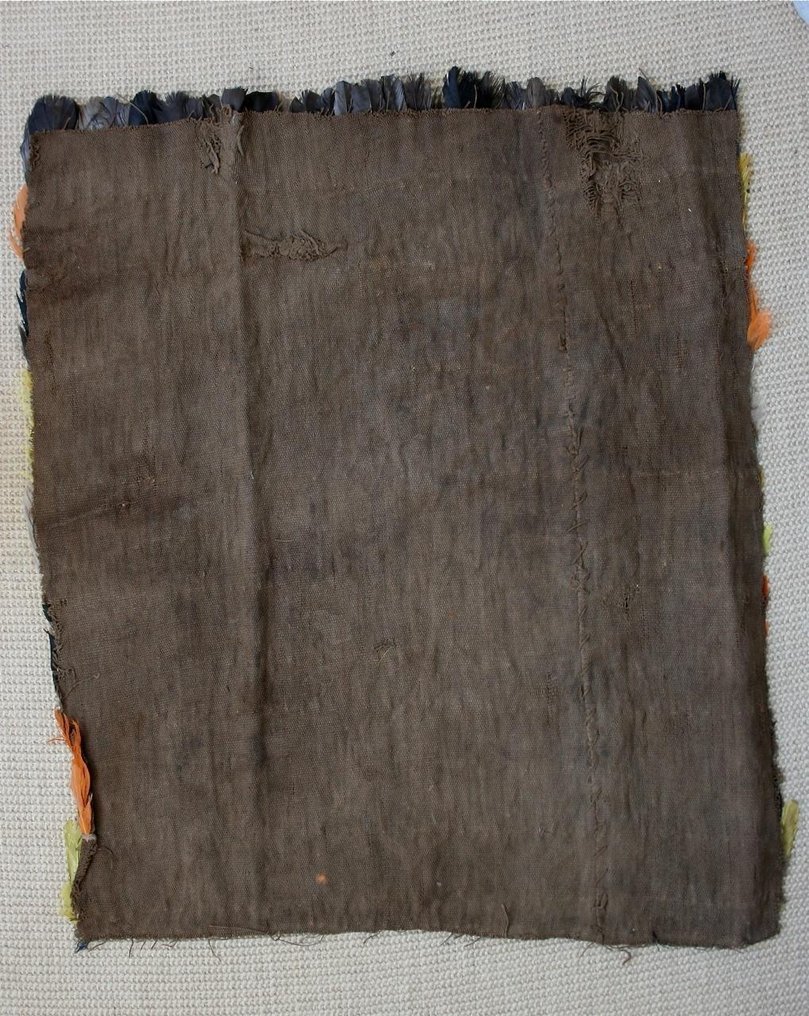
"The Pelican" is a type of seabird that has a large pouch under its beak that it uses to scoop up fish from the water. The pelican was a sacred animal for the Chancay people, as it represented abundance, fertility, and power. The pelican was associated with the sea god Ni, who was also known as Kon or Illapa. Ni was the creator of life and the ruler of the weathe
In terms of symbolism, the pelican's association with fishing and abundance could have made it a symbol of prosperity, sustenance, and fertility. It is possible that pelicans where depicted in art and iconography to represent these ideas, or they may have been featured as part of myths and narratives that conveyed important cultural and spiritual messages.
Feather work was a specialised craft that involved the use of various bird feathers to create exquisite textiles, garments, headdresses, and other decorative objects.
Skilled artisans meticulously collected, cleaned, and sorted feathers according to their colours and sizes. They then used various techniques to create intricate patterns and designs. Some common techniques included feather-piercing, where feathers were punctured and tied together to form a fabric-like surface, and feather mosaic, where small pieces of feathers were arranged to create detailed images.
Feather works served several purposes within pre-Columbian Peruvian societies. They were often used as ceremonial garments for high-ranking individuals, including priests, rulers, and warriors. These garments were symbols of status, power, and religious significance.
In addition to their use in clothing and accessories, feather works adorned architectural structures, including temples and palaces. Feathered tapestries and banners were hung as decorative elements, further showcasing the craftsmanship and artistic skills of the ancient Peruvian cultures.
The production of feather works required extensive knowledge of local bird species, their habitats, and their behaviours. Feathers were typically obtained through trade networks, as certain bird species were not native to all regions of ancient Peru. This trade in feathers helped foster connections between different cultures and regions.
Non-CITES Species Inspection Doc # ESAG5000523W: "Cairina moschata domestica " , commonly known as
Barbary ducks were domesticated by Native Americans since Pre-Columbian times.
The black and white feathers are difficult to identify, for the obvious reason that many birds have such plumage and, in addition, feather workers sometimes trimmed the feathers to refine the design, thus destroying the distinctive silhouette.The white plumage used by the Chimú, Chancay and Nazca cultures was made mainly from the feathers of seabirds, These birds are known for having white feathers on their bodies.
As for yellow or orange dyed feathers, the Chimú, Chancay and Nazca cultures used different sources to obtain the desired colours. Among the possible species used to dye feathers yellow are the achiote plant (Bixa orellana) and the palillo (Curcuma longa). These plants are known to produce yellow pigments used in textile dyeing.
To obtain orange-coloured feathers, the cultures mentioned may have used other natural sources, such as annatto in combination with other dyes or colour-mixing techniques.
Family Heirloom Private Collection Ex. Dr Rivadeneyra collection, Berlin late 1960s to early 1970s. To present owner by descent.Collected through the years by my father Dr. Jose Rivadeneyra Leon and by my grandfather Engr. Julio Rivadeneyra who lived in northern Peru central coast near Chiclayo.
Privately purchased and/or gifted by family members who loved collecting like his cousin,
Carlos Williams Leon who was a Peruvian renowned architect and archeologist. https://es.wikipedia.org/wiki/Carlos_Williams_Le%C3%B3n
Most of the collection was taken to Berlin in 1969 when my father was doing medical research there
Artwork with well-documented legal provenance and Spanish Historical Patrimony Export Certificate.
Any other costs or charges such as customs or import duties, customs clearance and handling may also apply during the shipment of your lot and will be charged to you by the involved party at a later stage if applicable.
The seller will provide all provenance information about the object to the buyer. The seller ensures that any necessary permits are/will be arranged. The seller will inform the buyer immediately about any delays in obtaining such permits.
If the piece goes outside the European Union a new export license will be requested by us, this process can take between 1 and 2 months. According to Spanish legislation, items sent outside the European Union are subject to export taxes and will be added to the invoice, at the buyer's expense. These export fees are fixed on the final auction price and the tax rate is not applied directly on the total value of the item to be exported, rather the different percentages by sections are applied to it:
- Up to 6,000 euros: 5%..- Shipped with Insurance.
Item legal to buy/sell under U.S. Statute covering cultural patrimony Code 2600, CHAPTER 14
This object is subject to the UNESCO Cultural Heritage Protection Act. For shipment to a non-EU member state, export regulations will vary.
"The Pelican" is a type of seabird that has a large pouch under its beak that it uses to scoop up fish from the water. The pelican was a sacred animal for the Chancay people, as it represented abundance, fertility, and power. The pelican was associated with the sea god Ni, who was also known as Kon or Illapa. Ni was the creator of life and the ruler of the weathe
In terms of symbolism, the pelican's association with fishing and abundance could have made it a symbol of prosperity, sustenance, and fertility. It is possible that pelicans where depicted in art and iconography to represent these ideas, or they may have been featured as part of myths and narratives that conveyed important cultural and spiritual messages.
Feather work was a specialised craft that involved the use of various bird feathers to create exquisite textiles, garments, headdresses, and other decorative objects.
Skilled artisans meticulously collected, cleaned, and sorted feathers according to their colours and sizes. They then used various techniques to create intricate patterns and designs. Some common techniques included feather-piercing, where feathers were punctured and tied together to form a fabric-like surface, and feather mosaic, where small pieces of feathers were arranged to create detailed images.
Feather works served several purposes within pre-Columbian Peruvian societies. They were often used as ceremonial garments for high-ranking individuals, including priests, rulers, and warriors. These garments were symbols of status, power, and religious significance.
In addition to their use in clothing and accessories, feather works adorned architectural structures, including temples and palaces. Feathered tapestries and banners were hung as decorative elements, further showcasing the craftsmanship and artistic skills of the ancient Peruvian cultures.
The production of feather works required extensive knowledge of local bird species, their habitats, and their behaviours. Feathers were typically obtained through trade networks, as certain bird species were not native to all regions of ancient Peru. This trade in feathers helped foster connections between different cultures and regions.
Non-CITES Species Inspection Doc # ESAG5000523W: "Cairina moschata domestica " , commonly known as
Barbary ducks were domesticated by Native Americans since Pre-Columbian times.
The black and white feathers are difficult to identify, for the obvious reason that many birds have such plumage and, in addition, feather workers sometimes trimmed the feathers to refine the design, thus destroying the distinctive silhouette.The white plumage used by the Chimú, Chancay and Nazca cultures was made mainly from the feathers of seabirds, These birds are known for having white feathers on their bodies.
As for yellow or orange dyed feathers, the Chimú, Chancay and Nazca cultures used different sources to obtain the desired colours. Among the possible species used to dye feathers yellow are the achiote plant (Bixa orellana) and the palillo (Curcuma longa). These plants are known to produce yellow pigments used in textile dyeing.
To obtain orange-coloured feathers, the cultures mentioned may have used other natural sources, such as annatto in combination with other dyes or colour-mixing techniques.
Family Heirloom Private Collection Ex. Dr Rivadeneyra collection, Berlin late 1960s to early 1970s. To present owner by descent.Collected through the years by my father Dr. Jose Rivadeneyra Leon and by my grandfather Engr. Julio Rivadeneyra who lived in northern Peru central coast near Chiclayo.
Privately purchased and/or gifted by family members who loved collecting like his cousin,
Carlos Williams Leon who was a Peruvian renowned architect and archeologist. https://es.wikipedia.org/wiki/Carlos_Williams_Le%C3%B3n
Most of the collection was taken to Berlin in 1969 when my father was doing medical research there
Artwork with well-documented legal provenance and Spanish Historical Patrimony Export Certificate.
Any other costs or charges such as customs or import duties, customs clearance and handling may also apply during the shipment of your lot and will be charged to you by the involved party at a later stage if applicable.
The seller will provide all provenance information about the object to the buyer. The seller ensures that any necessary permits are/will be arranged. The seller will inform the buyer immediately about any delays in obtaining such permits.
If the piece goes outside the European Union a new export license will be requested by us, this process can take between 1 and 2 months. According to Spanish legislation, items sent outside the European Union are subject to export taxes and will be added to the invoice, at the buyer's expense. These export fees are fixed on the final auction price and the tax rate is not applied directly on the total value of the item to be exported, rather the different percentages by sections are applied to it:
- Up to 6,000 euros: 5%..- Shipped with Insurance.
Item legal to buy/sell under U.S. Statute covering cultural patrimony Code 2600, CHAPTER 14
This object is subject to the UNESCO Cultural Heritage Protection Act. For shipment to a non-EU member state, export regulations will vary.
- 26
- 0
- 0
very nice Chancay weaving, good packaged and fastly delivered, friendly communication Thank you
Voir la traductionPieza interesante, de atractiva factura y de mayor tamaño al que había imaginado. Envío muy rápido en paquete bien protegido.
Voir la traductionGracias por la reseña. Saludos
vous avez à un passionné qui a hérité des œuvres magnifiques qui pourraient être dans des musées vous pouvez acheter les yeux fermés
Voir la traductionJe vous remercie pour vos commentaires.
Spedizione super veloce. Gli oggetti acquistati corrispondono esattamente alla descrizione e alle foto. Esperienza positiva. Sono soddisfatto.
Voir la traductionGrazie per il vostro feedback positivo
Tutto perfetto come al solito!
Voir la traductionEasy and fast transaction. Item as decribed.
Voir la traductionhttps://www.catawiki.com/en/l/78463619 Vielen Dank für Ihre positive Bewertung. Wir wissen das sehr zu schätzen. Mit freundlichen Grüßen Sergio
Friendly seller, good comunication, quick shipping.
Voir la traductionThank you Horacio for your kind feedback. We currently have a similar piece in auction Kind Regards Sergio https://www.catawiki.com/en/l/78527931-huari-inca-blue-cotton-camelid-panel-w-spanish-export-license-70x0-05x50-cm
Tout à fait parfait, merci.
Voir la traductionParfait, merci beaucoup!
Voir la traductionPerfecto, muchas gracias
Voir la traductionSuperbe œuvre d art Chimu. Civilisation dont je suis collectonneur depuis 30 ans. Merci beaucoup.
Voir la traductionMerci pour votre aimable commentaire
Perfecto, muchas gracias
Voir la traductionsent as promised. securely packed. a satisfied customer
Voir la traductionThank you for your positive feedback Regards Sergio
Perfecto, muchas gracias
Voir la traductionGracias a usted. Es un placer contemplar estas piezas históricas y confiarlas a una nueva custodia. Me alegro mucho de que haya llegado y de que estéis contentos. Que lo disfrutéis. Cordialmente SR
perfect
Voir la traductionBedankt voor jullie geduld. Ik ben zo blij dat het is aangekomen en dat je er blij mee bent. Veel plezier.
Beautiful object consistent with the description. Good responsiveness from the seller
Voir la traductionThank you for your kind comment. Regards
très bien
Voir la traductionCher Pierre : Merci encore pour votre achat. Sergio
Excelente vendedor, comunicación y envío. 100% recomendado+++
Voir la traductionGracias por sus comentarios positivos. Espero que la pieza te deleite muchas lunas
très bien. merci.
Voir la traductionNous vous remercions pour votre achat
Oggetto molto bello e interessante. Packaging molto accurato. Venditore consigliatissimo. Grazie.
Voir la traductionGrazie mille per il vostro feedback positivo
Excellent seller of incredible items. the items arrived quickly and packaged well. the communication by the seller was timely and provided shipping informatipn and information regarding the items.
Voir la traductionThank you for your feedback Regards Sergio
Thank you. Perfect.
Voir la traductionYou are so welcome. May it give you many years of enjoyment.
Tutto perfetto!
Voir la traduction“Grazie mille” – “prego”
Thanks! Nice object. 👌🙏
Voir la traduction- 26
- 0
- 0
Perfect transaction. Good communication and piece better than expected.
Voir la traductionMentions légales
Ce Lot est mis en vente par un particulier. En conséquence, vous ne disposez pas du droit de rétractation.
De la même manière, parce que ce Lot est mis en vente par un particulier, il ne bénéficie pas de la garantie légale de conformité des biens mentionnée aux articles L.217-4 et suivants du code de la consommation ainsi que de la garantie des défauts de la chose vendue énoncée aux articles 1641 et suivants du code civil.
Vendre un objet est un acte juridique, qui crée des obligations à votre égard et peut éventuellement engager votre responsabilité civile. Afin d’en savoir plus sur vos obligations, nous vous recommandons de consulter le lien suivant.
Mentions légales
Ce Lot est mis en vente par un particulier. En conséquence, vous ne disposez pas du droit de rétractation.
Mentions légales
Le vendeur garantit que l'objet a été obtenu légalement et est en mesure de le prouver. Le vendeur a été informé par Catawiki qu'il devait fournir les documents requis par les dispositions législatives et réglementaires de son pays de résidence. Le vendeur garantit qu’il est autorisé à vendre/exporter cet objet. Le vendeur fournira à l'acheteur toutes les informations connues sur la provenance de l'objet. Le vendeur veillera à ce que tous les permis nécessaires soient (déjà) obtenus. Le vendeur informera immédiatement l'acheteur en cas de retard dans l'obtention de ces permis.
Le vendeur garantit que l'objet a été obtenu légalement et est en mesure de le prouver. Le vendeur a été informé par Catawiki qu'il devait fournir les documents requis par les dispositions législatives et réglementaires de son pays de résidence. Le vendeur garantit qu’il est autorisé à vendre/exporter cet objet. Le vendeur fournira à l'acheteur toutes les informations connues sur la provenance de l'objet. Le vendeur veillera à ce que tous les permis nécessaires soient (déjà) obtenus. Le vendeur informera immédiatement l'acheteur en cas de retard dans l'obtention de ces permis.
Il est porté à l’attention des enchérisseurs que certains pays n'autorisent pas les objets importés dérivés d’espèces en voie de disparition et d'autres espèces protégées et ce, même si un certificat d'origine est fourni. En plaçant une offre, vous confirmez que vous avez pris connaissance des lois et des règlements douaniers de votre pays.
Il est porté à l’attention des enchérisseurs que certains pays n'autorisent pas les objets importés dérivés d’espèces en voie de disparition et d'autres espèces protégées et ce, même si un certificat d'origine est fourni. En plaçant une offre, vous confirmez que vous avez pris connaissance des lois et des règlements douaniers de votre pays.
